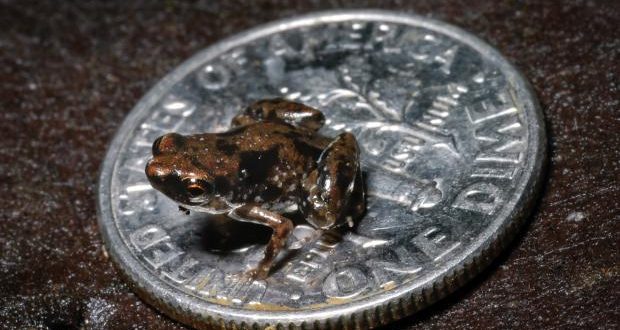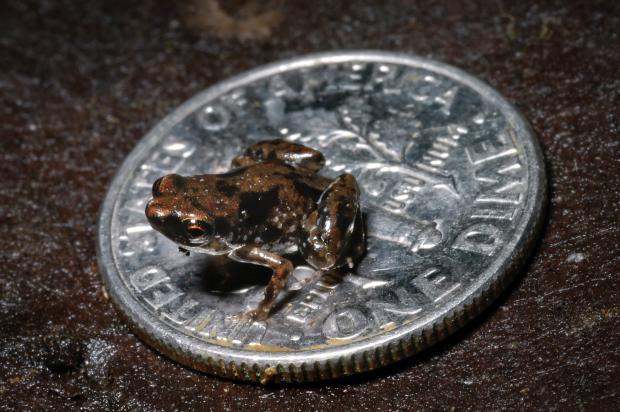Two new species of miniature frogs have been discovered by researchers from the United States. They say one of them, Paedophryne amauensis, is the world’s smallest frog.
Two new species of miniature frogs have been discovered by researchers from the United States. They say one of them, Paedophryne amauensis, is the world’s smallest frog – for now, at least – and that’s not all.
“Paedophryne amauensis, is also the world’s smallest vertebrate species, averaging about 7.7 mm in size,” Christopher Austin, study co-author and evolutionary biologist at Louisiana State University, told Science-Fare.com. “The other unusual thing about these frogs is they have a mating call that doesn’t sound like a frog call at all – it sounds like an insect call.”
The other species, Paedophryne swiftorum, isn’t much larger, averaging 8.5mm in size – that’s smaller than a dime.
A half-dozen of these frogs have now been discovered and are shedding more light on the genus in general, researchers say.
“They tell us the genus is more widespread than once thought,” Austin said. “Another future direction of our research is to find out what the distribution of the genus is.”
The new frogs are also shedding light on the evolution of miniaturization across all frogs, researchers say.
“We found multiple origins of miniaturization in frogs and it occurs almost exclusively in frogs that have direct developing larvae — so there’s no tadpole stage,” Austin said. “These miniature frogs, rather than being mere oddities of evolution, are probably doing something quite different from what normal frogs do.”
“They’re occupying a separate niche that really hasn’t been recognized before,” he added
The researchers believe it was an untapped food resource that drove miniaturization – and the frogs into forest floor.
“Being small allows you to dry out really easily,” Austin said. “When we find these frogs, we find them in really wet, deep and dense leaf litter that presumably never dries out.”
“Like other miniaturized frogs, they’re found in the tropics where it’s wet most of the time,” he added.
There, they’d also receive protection from predators, the researchers say.
The genus Paedophryne was first described by Fred Kraus in 2010 – he also described the world’s smallest frog in late 2011, before the record fell with P. amanuensis. The name has geek origins and refers to their juvenile appearance.
All six species have been found on the far eastern tip of Papua New Guinea – a hotspot for diverse species.
“The island of New Guineau is the tallest and largest tropical island in the world and occupies just 0.6 per cent of the world’s land area,” Austin said. “But, it harbours roughly five to seven per cent of the world’s biodiversity,”
“Every trip I go on, I return back with at least a handful of new species – if not more than that,” he added.
The frogs have claimed the title of world’s smallest vertebrate from a fish called Paedocypris progenetica. The smallest reported female at sexual maturity was just 7.9 mm.
The claim’s already being contested by other researchers in the scientific community. In fact, University of Washington ichthyologist, Theodore Pietsch found a male anglerfish that’s 0.8 mm smaller than the smallest frog Austin described – 7.7mm is the average length – and The Guinness Book of World Records has awarded it the title of world’s smallest vertebrate.
Austin told Science-Fare.com the measurement doesn’t include the female anglerfish of the same species. It’s approximately 50 mm long, so although it may be the world’s smallest vertebrate male, it’s not the world’s smallest vertebrate species.
In a statement to Science-Fare.com, a spokesperson for The Guinness Book of World Records told us the research team is looking into the matter — of course we’ll let you know when we hear from them.
The research was published in the latest issue of the Journal, PLoS One.
 Science Fare Media Science News – Upgraded
Science Fare Media Science News – Upgraded



